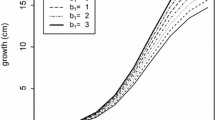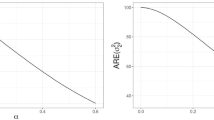Abstract
Linear mixed modeling (LMM) is a comprehensive technique used for clustered, panel and longitudinal data. The main assumption of classical LMM is having normally distributed random effects and error terms. However, there are several situations for that we need to use heavier tails distributions than the (multivariate) normal to handle outliers and/or heavy tailness in data. In this study, we focus on LMM using the multivariate Laplace distribution which is known as the heavy tailed alternative to the normal distribution. The parameter estimators of interest are generated with EM algorithm for the proposed model. A simulation study is provided to illustrate the performance of the Laplace distribution over the normal distribution for LMM. Also, a real data example is used to explore the behavior of the proposed estimators over the counterparts.




Similar content being viewed by others
References
Arellano-Valle RB, Bolfarine H, Lachos VH (2005) Skew-normal linear mixed models. J Data Sci 3:415–438
Arslan O (2010) An alternative multivariate skew Laplace distribution: properties and estimation. Stat Pap 51:865–887
Barndorff-Nielsen O (1978) Hyperbolic distributions and distributions on hyperbolae. Scand J Stat 5:151–157
Barndorff-Nielsen O, Halgreen C (1977) Infinite divisibility of the hyperbolic and generalized inverse Gaussian distributions. Z Wahrscheinlichkeitstheorie verw Gebiete 38:309–311
Box GEP, Tiao GC (1973) Bayesian inference in statistical analysis. Wiley, New York
Choudhary PK, Sengupta D, Cassey P (2014) A general skew-t mixed model that allows different degrees of freedom for random effects and error distributions. J Stat Plan Inference 147:235–247
Demidenko E (2004) Mixed models: theory and applications. Wiley, New York
Dempster AP, Laird NM, Rubin DB (1977) Maximum likelihood from incomplete data via the EM algorithm. J R Stat Soc Ser B (Methodol) 39:1–38
Eisenhart C (1947) The assumptions underlying the analysis of variance. Biometrics 3:1–21
Fang KT, Kotz S, Ng FW (1990) Symmetric multivariate and related distributions. Chapman and Hall, London
Gómez E, Gomez-Viilegas MA, Marín JM (1998) A multivariate generalization of the power exponential family of distributions. Commun Stati Theory Methods 27:589–600
Gómez-Sánchez-Manzano E, Gómez-Villegas MA, Marín JM (2006) Sequences of elliptical distributions and mixtures of normal distributions. J Multivar Anal 97:295–310
Gómez-Sánchez-Manzano E, Gómez-Villegas MA, Marín JM (2008) Multivariate exponential power distributions as mixtures of normal distributions with Bayesian applications. Commun Stat Theory Methods 37:972–985
Gómez-Villegas M, Gómez-Sánchez-Manzano E, Maín P, Navarro H (2011) The effect of non-normality in the power exponential distributions. Understanding complex systems. In: Pardo L, Balakrishnan N, Gil M (eds) Modern mathematical tools and techniques in capturing complexity. Springer, Berlin Heidelberg, pp 119–129
Hampel FR, Ronchetti EM, Rousseeuw PJ, Stahel WA (1986) Robust statistics: the approach based on influence functions. Wiley, New York
Harville DA (1977) Maximum likelihood approaches to variance component estimation and to related problems. J Am Stat Assoc 72:320–338
Healy M, Westmacott M (1956) Missing values in experiments analysed on automatic computers. J R Stat Soc Ser C (Appl Stat) 5:203–206
Henderson CR (1950) Estimation of genetic parameters. Ann Math Stat 21:309–310
Huber PJ (1973) Robust regression: asymptotics, conjectures and Monte Carlo. Ann Math Stat 1:799–821
Huber PJ (1981) Robust statistics. Wiley, New York
Jorgensen B (1982) Statistical properties of the generalized inverse Gaussian distributions, vol 9. Lecture Notes in statistics, Springer, New York
Kleinbaum DG (1973) A generalization of the growth curve model which allows missing data. J Multivar Anal 3:117–124
Lachos VH, Dey DK, Cancho VG (2009) Robust linear mixed models with skew-normal independent distributions from a Bayesian perspective. J Stat Plan Inference 139:4098–4110
Laird NM, Ware JH (1982) Random-effects models for longitudinal data. Biometrics 38:963–974
Lange KL, Little RJA, Taylor JMG (1989) Robust statistical modeling using the t distribution. J Am Stat Assoc 84:881–896
Lin TI (2008) Longitudinal data analysis using t linear mixed models with autoregressive dependence structures. J Data Sci 6:333–355
Lin T, Lee J (2008) Estimation and prediction in linear mixed models with skew-normal random effects for longitudinal data. Stat Med 27:1490–1507
Lindstrom MJ, Bates DM (1988) Newton-Raphson and EM algorithms for linear mixed-effects models for repeated-measures data. J Am Stat Assoc 83:1014–1022
McCulloch CE, Searle SR (2001) Generalized, linear, and mixed models. Wiley, New York
McLachlan GJ, Krishnan T (1997) The EM algorithm and extensions. Wiley Series in Probability and Statistics, New York
Meng X-L, Rubin DB (1993) Maximum likelihood estimation via the ECM algorithm: a general framework. Biometrika 80:267–278
Osorio F, Paula GA, Galea M (2007) Assessment of local influence in elliptical linear models with longitudinal structure. Comput Stat Data Anal 51:4354–4368
Pinheiro JC, Bates DM (2000) Mixed-effects models in S and S-Plus. Springer-Verlag, New York
Pinheiro JC, Liu C, Wu YN (2001) Efficient algorithms for Robust estimation in linear mixed-effects models using the multivariate t distribution. J Comput Graph Stat 10:249–276
Potthoff RF, Roy SN (1964) A generalized multivariate analysis of variance model useful especially for growth curve problems. Biometrika 51:313–326
Raudenbush SW, Bryk AS (2002) Hierarchical linear models: applications and data analysis methods. Sage Publications, Newbury Park
Samorodnitsky G, Taqqu MS (1994) Stable non-Gaussian random processes: stochastic models with infinite variance. Chapman and Hall, New York
Searle SR, Casella G, McCulloch CE (1992) Variance components. Wiley, New York
Verbeke G, Lesaffre E (1996) A linear mixed-effects model with heterogeneity in the random-effects population. J Am Stat Assoc 91:217–221
Verbeke G, Molenberghs G (2000) Linear mixed models for longitudinal data. Springer, New York
Watson GN (1966) A treatise on the theory of Bessel functions. Cambridge University Press, London
West BT, Welch KB, Galeckl AT (2007) Linear mixed models: a practical guide using statistical software. CRC Press LLC, Boca Raton
West M (1987) On scale mixtures of normal distributions. Biometrika 74:646–648
Wu CFJ (1983) On the convergence properties of the EM algorithm. Ann Stat 11:95–103
Zellner A (1976) Bayesian and non-Bayesian analysis of the regression model with multivariate student-t error terms. J Am Stat Assoc 71:400–405
Acknowledgments
The authors thank the Editor and two anonymous referees for valuable suggestions that greatly improved the paper.
Author information
Authors and Affiliations
Corresponding author
Rights and permissions
About this article
Cite this article
Yavuz, F.G., Arslan, O. Linear mixed model with Laplace distribution (LLMM). Stat Papers 59, 271–289 (2018). https://doi.org/10.1007/s00362-016-0763-x
Received:
Revised:
Published:
Issue Date:
DOI: https://doi.org/10.1007/s00362-016-0763-x




